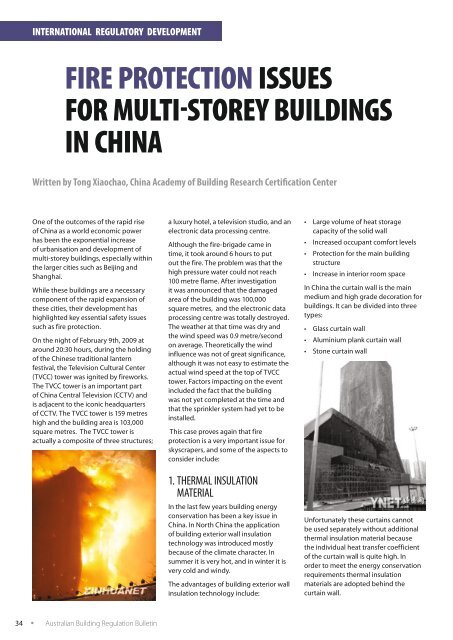BCA 2010 - ABCB - Australian Building Codes Board
BCA 2010 - ABCB - Australian Building Codes Board
BCA 2010 - ABCB - Australian Building Codes Board
You also want an ePaper? Increase the reach of your titles
YUMPU automatically turns print PDFs into web optimized ePapers that Google loves.
INTERNATIONAL Regulatory Development<br />
FIRE PROTECTION ISSUES<br />
FOR MULTI-STOREY BUILDINGS<br />
IN CHINA<br />
Written by Tong Xiaochao, China Academy of <strong>Building</strong> Research Certification Center<br />
One of the outcomes of the rapid rise<br />
of China as a world economic power<br />
has been the exponential increase<br />
of urbanisation and development of<br />
multi-storey buildings, especially within<br />
the larger cities such as Beijing and<br />
Shanghai.<br />
While these buildings are a necessary<br />
component of the rapid expansion of<br />
these cities, their development has<br />
highlighted key essential safety issues<br />
such as fire protection.<br />
On the night of February 9th, 2009 at<br />
around 20:30 hours, during the holding<br />
of the Chinese traditional lantern<br />
festival, the Television Cultural Center<br />
(TVCC) tower was ignited by fireworks.<br />
The TVCC tower is an important part<br />
of China Central Television (CCTV) and<br />
is adjacent to the iconic headquarters<br />
of CCTV. The TVCC tower is 159 metres<br />
high and the building area is 103,000<br />
square metres. The TVCC tower is<br />
actually a composite of three structures;<br />
a luxury hotel, a television studio, and an<br />
electronic data processing centre.<br />
Although the fire-brigade came in<br />
time, it took around 6 hours to put<br />
out the fire. The problem was that the<br />
high pressure water could not reach<br />
100 metre flame. After investigation<br />
it was announced that the damaged<br />
area of the building was 100,000<br />
square metres, and the electronic data<br />
processing centre was totally destroyed.<br />
The weather at that time was dry and<br />
the wind speed was 0.9 metre/second<br />
on average. Theoretically the wind<br />
influence was not of great significance,<br />
although it was not easy to estimate the<br />
actual wind speed at the top of TVCC<br />
tower. Factors impacting on the event<br />
included the fact that the building<br />
was not yet completed at the time and<br />
that the sprinkler system had yet to be<br />
installed.<br />
This case proves again that fire<br />
protection is a very important issue for<br />
skyscrapers, and some of the aspects to<br />
consider include:<br />
1. Thermal insulation<br />
material<br />
In the last few years building energy<br />
conservation has been a key issue in<br />
China. In North China the application<br />
of building exterior wall insulation<br />
technology was introduced mostly<br />
because of the climate character. In<br />
summer it is very hot, and in winter it is<br />
very cold and windy.<br />
The advantages of building exterior wall<br />
insulation technology include:<br />
• Large volume of heat storage<br />
capacity of the solid wall<br />
• Increased occupant comfort levels<br />
• Protection for the main building<br />
structure<br />
• Increase in interior room space<br />
In China the curtain wall is the main<br />
medium and high grade decoration for<br />
buildings. It can be divided into three<br />
types:<br />
• Glass curtain wall<br />
• Aluminium plank curtain wall<br />
• Stone curtain wall<br />
Unfortunately these curtains cannot<br />
be used separately without additional<br />
thermal insulation material because<br />
the individual heat transfer coefficient<br />
of the curtain wall is quite high. In<br />
order to meet the energy conservation<br />
requirements thermal insulation<br />
materials are adopted behind the<br />
curtain wall.<br />
34 • <strong>Australian</strong> <strong>Building</strong> Regulation Bulletin

















